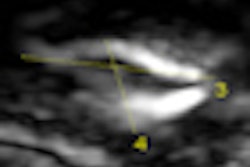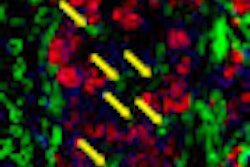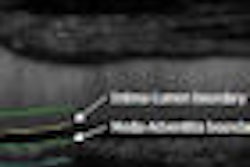Color Doppler ultrasound indices can predict disease-free survival of breast cancer patients during neoadjuvant chemotherapy, according to research published in the European Journal of Radiology.
In a prospective study of 50 patients, researchers found that patients with higher intratumoral blood velocity on color Doppler scans after chemotherapy were twice as likely to have their cancer recur or metastasize than those who showed decreased velocity after surgery.
"Tumor flow velocity measured by Doppler ultrasound can be used as an independent marker of disease-free survival in patients with breast cancer," wrote a research team led by Dr. Gurpreet Singh of All India Institute of Medical Sciences (AIIMS) in New Delhi, India.
Seeking to examine the role of color Doppler ultrasound in evaluating change in blood-flow velocity in locally advanced and inflammatory breast cancer before and after neoadjuvant chemotherapy, the researchers enrolled 50 consecutive breast cancer patients with a mean age of 46 (Eur J Rad, available online January 13, 2009).
All patients received Doppler ultrasound of their breast tumors using an EnVisor ultrasound system (Philips Healthcare, Andover, MA). Doppler indices such as pulsatility index (PI), resistive index (RI), and peak systolic velocity (PSV) were recorded by an experienced radiologist, according to the researchers.
Any changes to Doppler parameters following three cycles of chemotherapy were graded on a four-point scale: grade 1 (increase, no change, or decrease of less than 25% in Doppler parameters), grade 2 (25% to 50% decrease), grade 3 (more than 50% decrease but not complete tumor disappearance), and grade 4 (complete disappearance of Doppler flow).
The researchers followed patients for 24 months after treatment and compared Doppler scores with clinical findings. On the color Doppler ultrasound performed prior to therapy, all 50 patients had hypervascular signals.
Of the 16 patients who experienced an increase in PSV after chemotherapy, 11 (68.75%) had ipsilateral recurrence, contralateral disease, locoregional disease recurrence, and distant metastasis, compared with five (31.25%) who had a decrease of PSV after chemotherapy.
The differences were judged to be statistically significant (p < 0.05). Neither pulsatility index nor resistive index was found to correlate with clinical response to treatment.
"Color Doppler has the potential for precisely directed blood flow velocity measurement and also offers unique functional information that may be of importance in terms of overall disease-free survival of women with breast cancer," the researchers wrote.
By Erik L. Ridley
AuntMinnie.com staff writer
January 26, 2010
Related Reading
Targeted breast US stands on its own for women under 30, December 24, 2009
CEUS boosts differentiation of BI-RADS 4 lesions, December 23, 2009
Ultrasound signals of asymptomatic emboli predict stroke risk, December 7, 2009
MRI volume navigation adds accuracy to second-look breast ultrasound, November 11, 2009
Exhibit examines reasons for missed breast ultrasound studies, November 11, 2009
Copyright © 2010 AuntMinnie.com



















